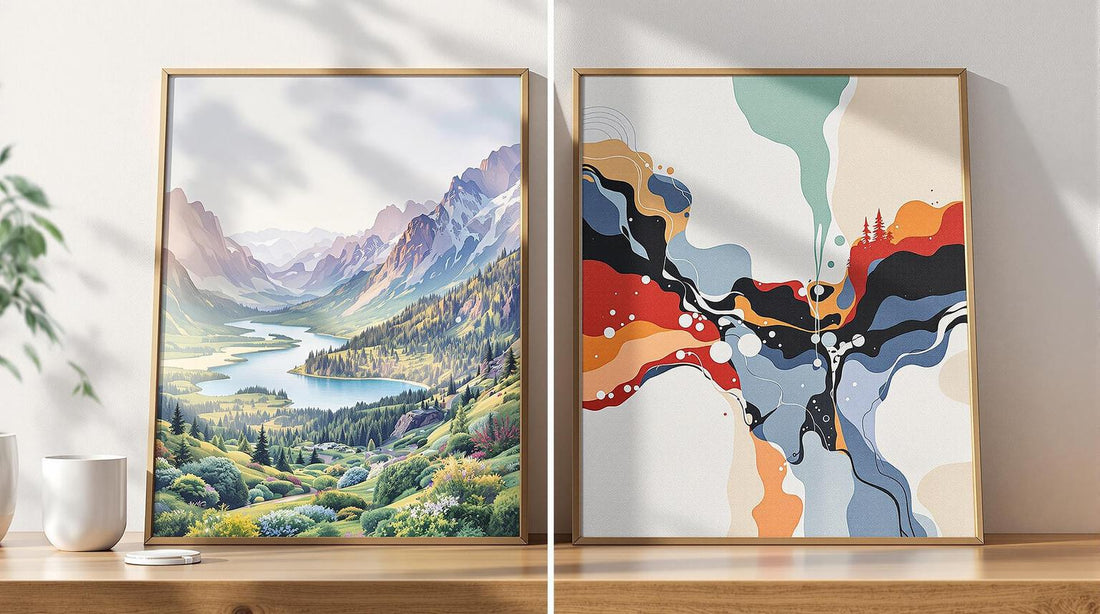Giclée prints last longer and keep their colors better than offset prints. Why? Giclée uses pigment-based inks on acid-free materials, making them resistant to fading. Offset printing, while cost-effective for large runs, uses dye-based inks that fade faster.
Key Takeaways:
- Giclée Printing: Durable, fade-resistant, vibrant colors, ideal for long-term display.
- Offset Printing: Affordable for bulk printing but fades quicker under light exposure.
- Durability Factors: Ink type, paper quality, and display conditions (e.g., avoiding sunlight and using UV-protective glass) impact longevity.
| Printing Method | Ink Type | Durability | Best For |
|---|---|---|---|
| Giclée | Pigment-based | High (90% color retention after 2,000 lux·hours) | Fine art, archival-quality prints |
| Offset | Dye-based | Moderate (below 70% color retention under the same conditions) | Large-scale, cost-efficient runs |
To keep prints looking their best, choose giclée for high-quality, long-lasting results and store them in stable, low-humidity environments away from direct sunlight.
Main Printing Methods
Giclée Printing Process
Giclée printing relies on pigment-based inks applied to archival-quality materials. This method delivers sharp details, rich colors, and excellent resistance to fading over time.
Offset Printing Process
Offset printing uses dye-based inks transferred from metal plates. It’s known for consistent color reproduction and cost efficiency for large print runs. However, prints from this method are more prone to fading compared to giclée [2].
Up next, we'll evaluate how each method holds up under common display conditions.
What is the difference between a Lithograph and a Giclee ...
Print Method Durability Analysis
Tests measuring accelerated light exposure reveal that giclée prints maintain over 90% of their original color density after 2,000 lux·hours. In comparison, offset prints drop below 70% under identical conditions. These findings highlight the importance of factors like ink composition, paper selection, and display environments in determining how long prints last.
sbb-itb-78c8b21
What Affects Print Life
When evaluating print methods, it's essential to consider three main factors that influence durability: ink composition, display conditions, and substrate choice. These elements work together to determine how long a print will last, beyond just the printing method itself.
Ink Types and Paper Choice
The type of ink and the paper used play a big role in how long a print endures. Pigment-based inks tend to hold up better against fading compared to dye-based inks. Additionally, using substrates that are acid- and lignin-free, with a neutral-to-alkaline pH, helps prevent yellowing and brittleness over time.
Display Conditions
Environmental factors like temperature, humidity, and lighting significantly impact print longevity. Keeping prints in stable conditions with controlled temperature and humidity, along with low-UV lighting and UV-filtering glass, can preserve them longer. On the other hand, fluctuating climates can cause paper to warp and foster mold, while direct sunlight can break down pigments.
Print Surface Materials
The choice of substrate - whether fine art paper, canvas, or metal - affects both the print's look and its durability. For example, cotton-rag papers are less prone to aging, canvas resists cracking, and metal provides excellent stability. Surface texture and protective coatings also influence how ink is absorbed and how well colors are preserved.
Eco-Friendly Print Options
Eco-friendly printing combines long-lasting quality with environmentally conscious practices. By producing items only when ordered, it reduces surplus inventory and material waste. Using archival-grade papers ensures colors remain vivid over time, while avoiding the need to store unsold prints.
OMG Kitty employs made-to-order giclée printing on high-quality archival paper. Every piece is hand-designed in the UK and available in sizes ranging from A4 (8.3×11.7″) to A1 (23.4×33.1″). They also provide worldwide tracked shipping, with prices starting at $24.
Conclusion
Giclée prints, made with fade-resistant pigment inks on acid-free paper, are known for their lasting vibrancy. To preserve their quality, it's essential to use UV-protective glass for framing and keep them in a stable, low-humidity setting. Displaying these prints away from direct sunlight will help maintain their rich colors for many years. Collectors looking for durability and brilliance should consider giclée prints as a worthwhile choice.

